Imagine stepping into a serene oasis where the warm sun meets the cool sea breeze. This is what Mediterranean interior design is all about. It’s a timeless look that has won over many. It brings together the beauty of the Mediterranean Sea’s shores and the rich cultures of the area.
This design style has a long history, starting with ancient Greece, Rome, Egypt, and the Phoenicians. Over time, it has been shaped by Moorish, Italian Renaissance, and Ottoman styles. Today, it’s loved for its warm colors, natural materials, and the way it blends indoor and outdoor spaces.
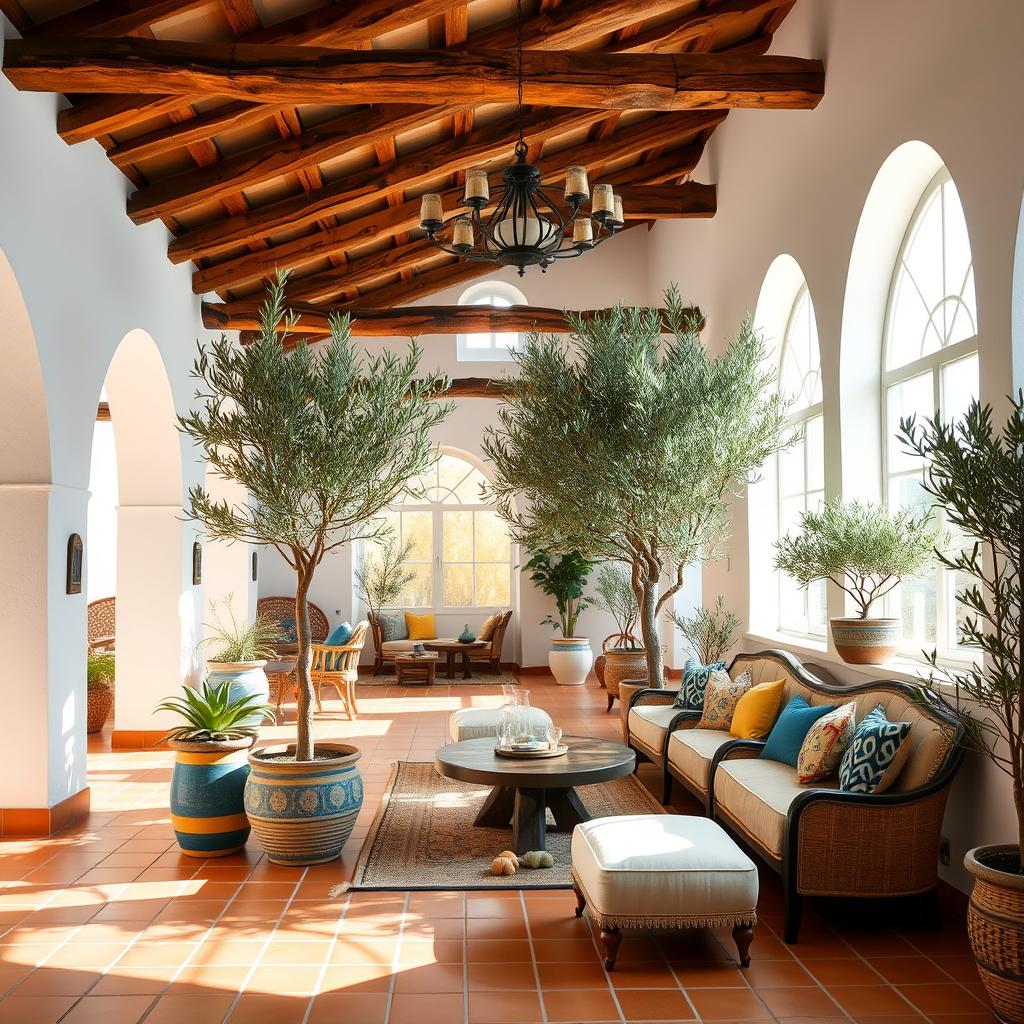
If you want to change your home or just need some design ideas, learning about Mediterranean interior design is key. It’s all about a specific color scheme, handmade furniture, and bringing nature inside. Let’s explore how to create a peaceful and welcoming space with this timeless style.
The Origins and History of Mediterranean Interior Design
The Mediterranean Interior Design style comes from a mix of cultures. Ancient Greek homes taught us about harmony and balance. Spanish Villas added rustic charm, while Moroccan riads brought ornate details. Together, they created the Mediterranean look we love today.
Ancient Greece, Rome, Egypt, and the Phoenicians
The Mediterranean has always been a place where cultures meet. Ancient Greeks, Romans, Egyptians, and Phoenicians left their mark. Their designs, from Greek symmetry to Roman grandeur, shape the Mediterranean style we admire.
The Moorish Influence in the Iberian Peninsula
The Moors, a Muslim people from North Africa, changed Spain and Portugal. Their designs, with carved arches and tiles, are key to Mediterranean style.
The Italian Renaissance and Its Impact
The Italian Renaissance was a big influence on Mediterranean design. It brought back Roman classics like domes and columns. These elements mix well with the region’s natural beauty and colors.
The Ottoman Empire’s Architectural Legacy
The Ottoman Empire, covering parts of the Mediterranean, left a lasting mark. Their rich interiors, with textiles and woodwork, are now part of the Mediterranean style.
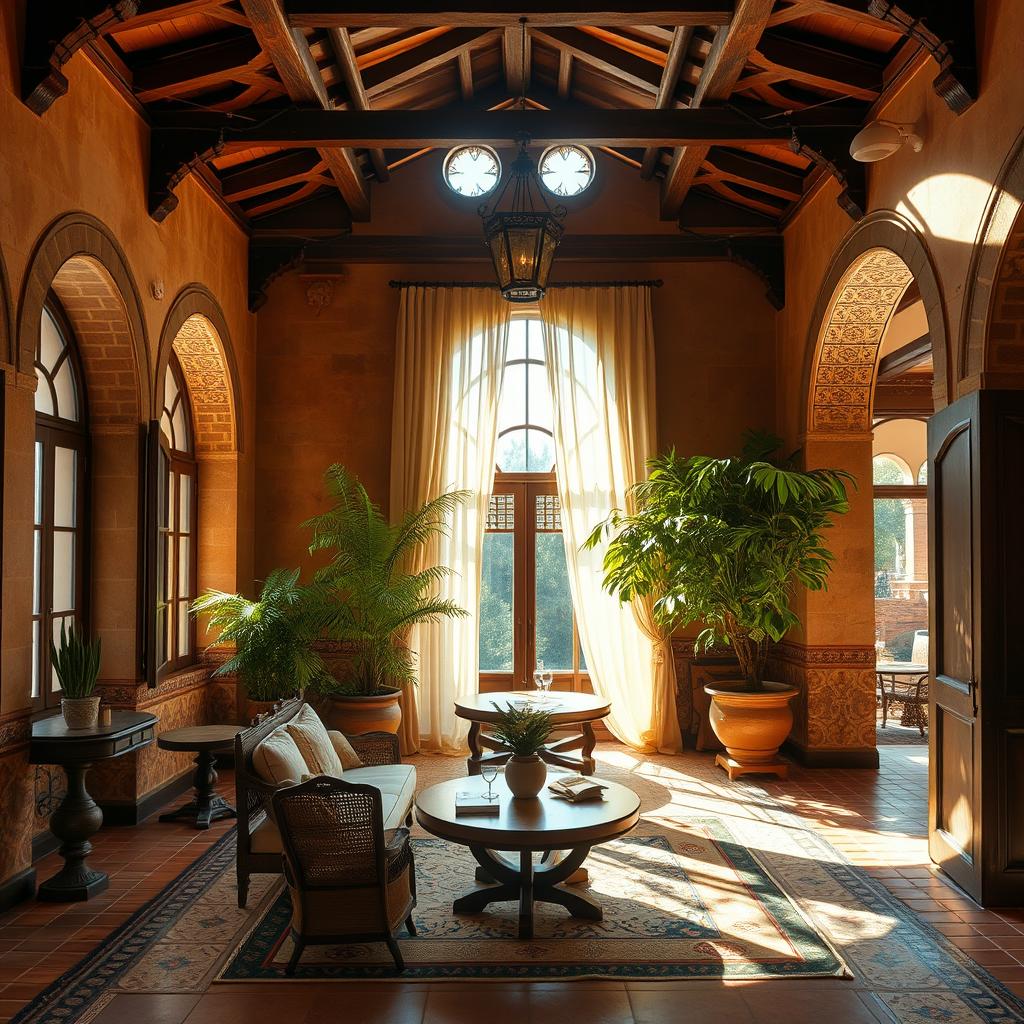
Key Characteristics of Mediterranean Interior Design
Mediterranean interior design is known for its bright and earthy colors, natural materials, and handmade furniture. It shows the rich history and varied cultures of the area. The design combines timeless beauty with a rustic feel, inspired by the sunny landscapes and blue waters.
Color Palette: Warm and Earthy Hues
The Mediterranean design style features a rich color scheme inspired by the Mediterranean coast. Warm colors like terracotta, ochre, and olive green mix with cool shades of turquoise, cobalt blue, and white. These colors make the space welcoming and full of life, capturing the Mediterranean’s spirit.
Materials and Textures: Natural and Rustic
Mediterranean interiors use a lot of natural materials like stone, wood, and ceramic. You’ll see textured walls, exposed wooden beams, and terracotta tiles. These elements add depth and authenticity, showing the region’s traditional building methods and love for the outdoors.
Furniture and Decor: Handcrafted and Ornate
Furniture in Mediterranean design is sturdy yet elegant, often made from wood and iron or brass. It has detailed carvings and craftsmanship. Decor includes handmade ceramics, colorful mosaics, and greenery, bringing nature inside and highlighting the Mediterranean decor style features of skill and ornate details.
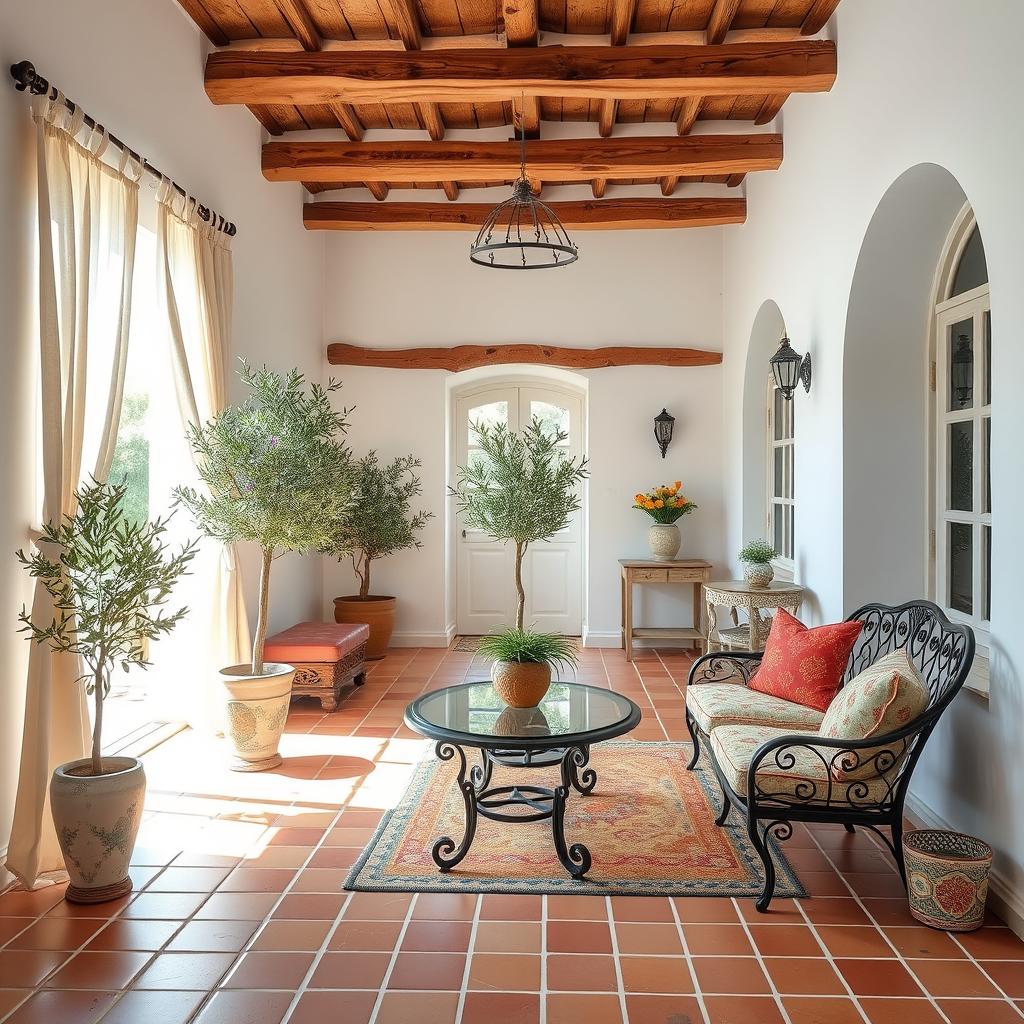
| Key Characteristics of Mediterranean Interior Design |
|---|
| Color Palette: Warm and Earthy Hues |
| Materials and Textures: Natural and Rustic |
| Furniture and Decor: Handcrafted and Ornate |
Architectural Elements of Mediterranean Design
Mediterranean interior design is more than just looks. It’s built on architectural elements that make it timeless. High ceilings, arched doorways, and big windows let in lots of natural light. These features make spaces feel open and airy, key to Mediterranean homes.
High Ceilings, Arched Doorways, and Expansive Windows
High ceilings are a big part of Mediterranean architecture. They make rooms feel bigger and more impressive. Arched doorways add elegance and help rooms flow smoothly together. Big windows bring in lots of light, making indoor and outdoor spaces feel connected.
Open Floor Plans and Natural Light
Mediterranean design loves open floor plans. They make moving around easy and encourage socializing. With lots of natural light, thanks to big windows and glass doors, these homes feel bright and welcoming.

Mediterranean Interior Design Color Palette
The Mediterranean Interior Design color palette is key to this style. It’s inspired by the natural beauty of the Mediterranean coast. Warm colors like terracotta, ochre, and olive green mix with cool shades of turquoise, cobalt blue, and white. These colors bring to mind the sun, sea, and sky of the Mediterranean, making spaces feel welcoming and harmonious.
Earthy tones are a big part of Mediterranean design. Warm browns and burnt oranges add comfort and energy. Cool greens inspired by the region’s foliage balance these warm colors. Joyful yellows and green-blues add a pop of energy.
Classic Mediterranean design also includes crisp white for elegance and airiness. Charcoal gray adds depth, while creamy ivory enhances warmth. This color palette works well in both modern and traditional settings, making it a timeless choice.
| Color | Inspiration | Design Application |
|---|---|---|
| Terracotta | Roofs and tiles of Mediterranean buildings | Warm, earthy base for Mediterranean interiors |
| Olive Green | Lush Mediterranean foliage | Calming, natural accent color |
| Turquoise | Sparkling Mediterranean waters | Refreshing, vibrant accent color |
| Cobalt Blue | Clear Mediterranean skies | Elegant, bold accent color |
| Crisp White | Whitewashed Mediterranean architecture | Airy, light base for Mediterranean interiors |
Using the mediterranean color palette, mediterranean color scheme, and mediterranean interior design colors brings the Mediterranean lifestyle to life. It creates spaces that feel inviting and elegant, like a sunny day by the sea.
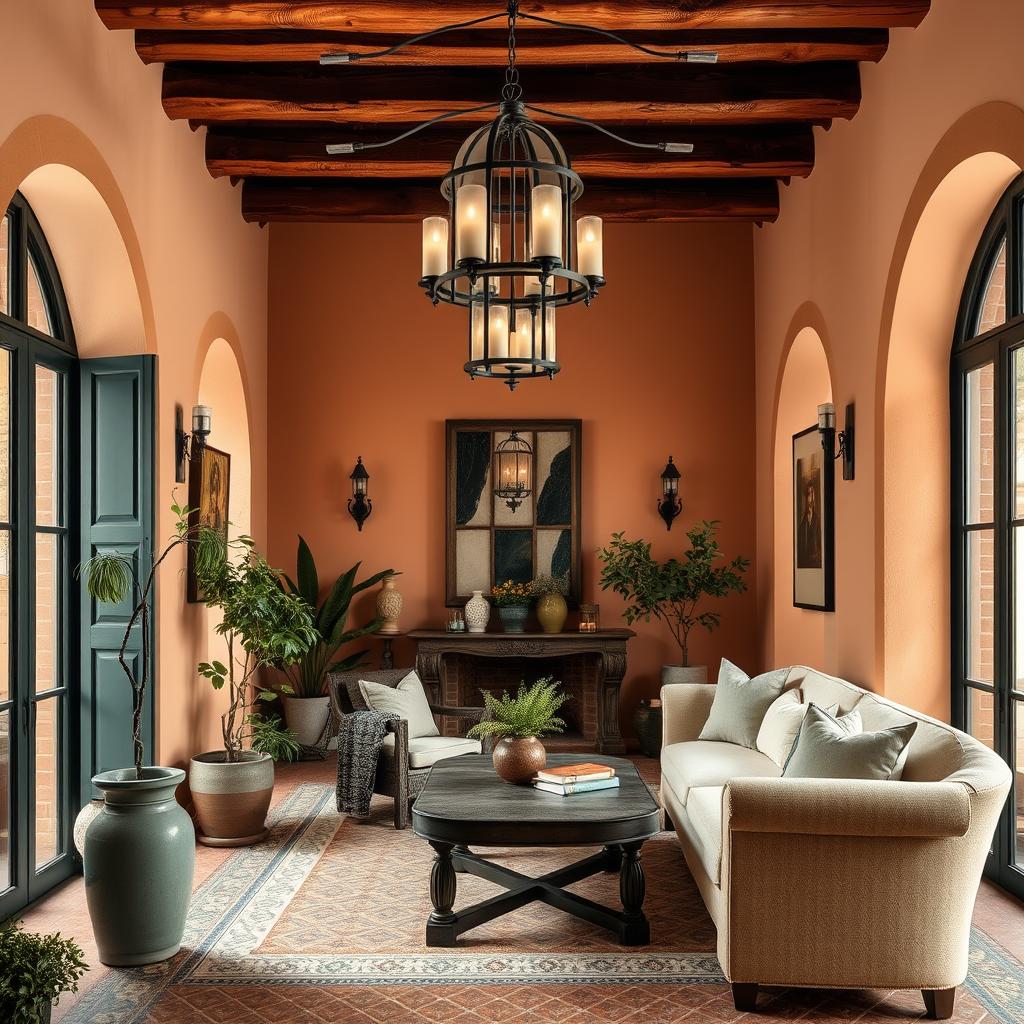
Natural Materials in Mediterranean Interiors
Mediterranean interiors are known for their natural materials. These add a timeless charm to the space. Features like rustic stone walls and exposed wooden beams show the Mediterranean’s love for nature.
Stone is a key material in Mediterranean design. It’s used for floors, fireplaces, and walls. Terracotta tiles are also common, adding warmth with their earthy tones.
Natural woods are everywhere, from floors to furniture. Exposed wooden beams make spaces cozy and elegant. They add a rustic touch.
Ceramics and textured plaster walls are also key. They provide a neutral background for other materials. These elements enhance both the look and feel of the space.
Using Mediterranean home interior materials makes interiors timeless and sophisticated. It connects them to the Mediterranean’s natural heritage.
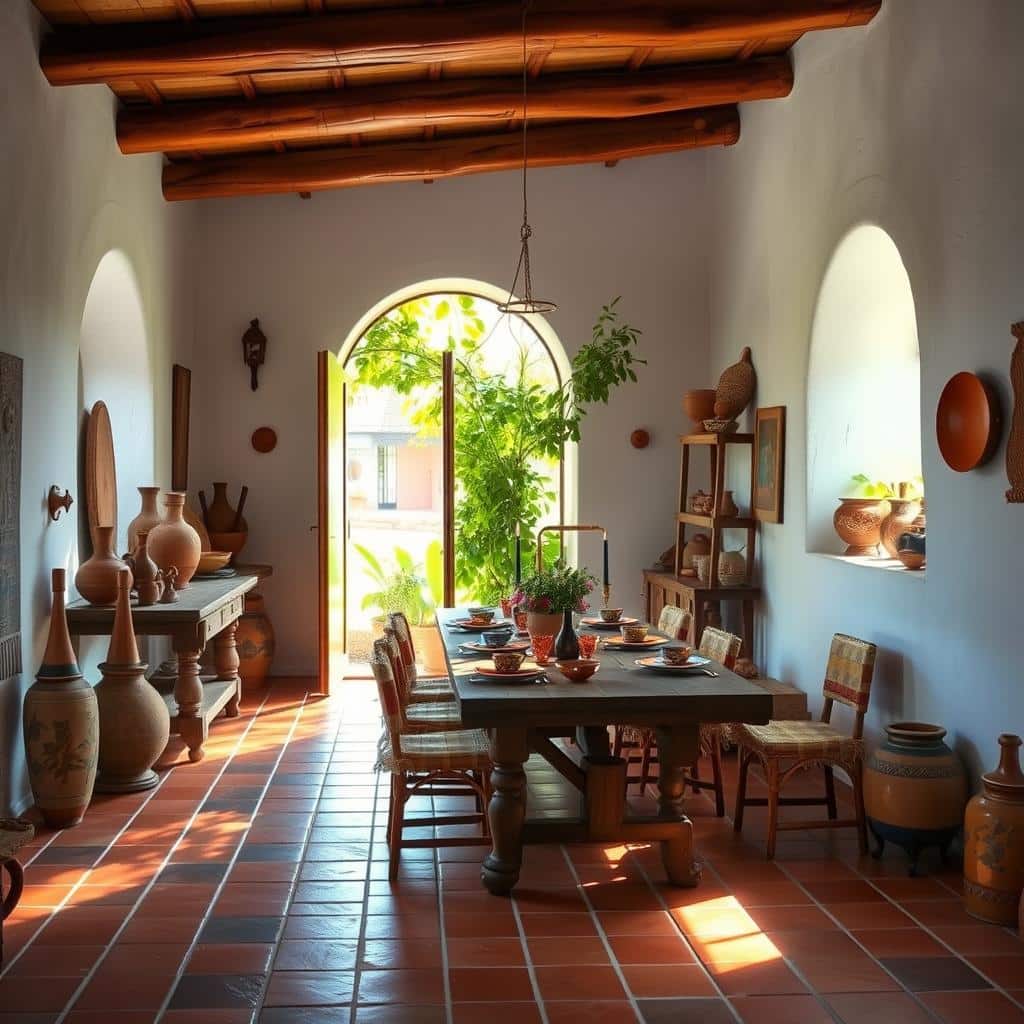
Choosing natural materials in Mediterranean interiors is more than a design choice. It reflects the region’s culture and history. These materials, used for centuries, create a lasting and authentic look.
Mediterranean Furniture and Decor Styles
Mediterranean interior design is known for its timeless beauty and perfect mix of function and style. At its core are the mediterranean furniture and decor pieces. These items bring the rich culture of the Mediterranean to life.
Furniture in Mediterranean homes is strong and beautiful. Wooden pieces often have detailed carvings and metal accents. The upholstery uses natural fabrics like linen and cotton, with patterns from simple stripes to detailed flowers.
Mediterranean decor items are key in capturing the region’s spirit. Handmade ceramics, colorful mosaics, and green plants add to the timeless elegance and connection to nature.
The Mediterranean interior design furniture and decor create spaces that are both stunning and practical. Whether it’s a cozy reading spot or a big area for parties, Mediterranean style blends indoors and outdoors. It invites everyone to enjoy the beauty and comfort of these designs.
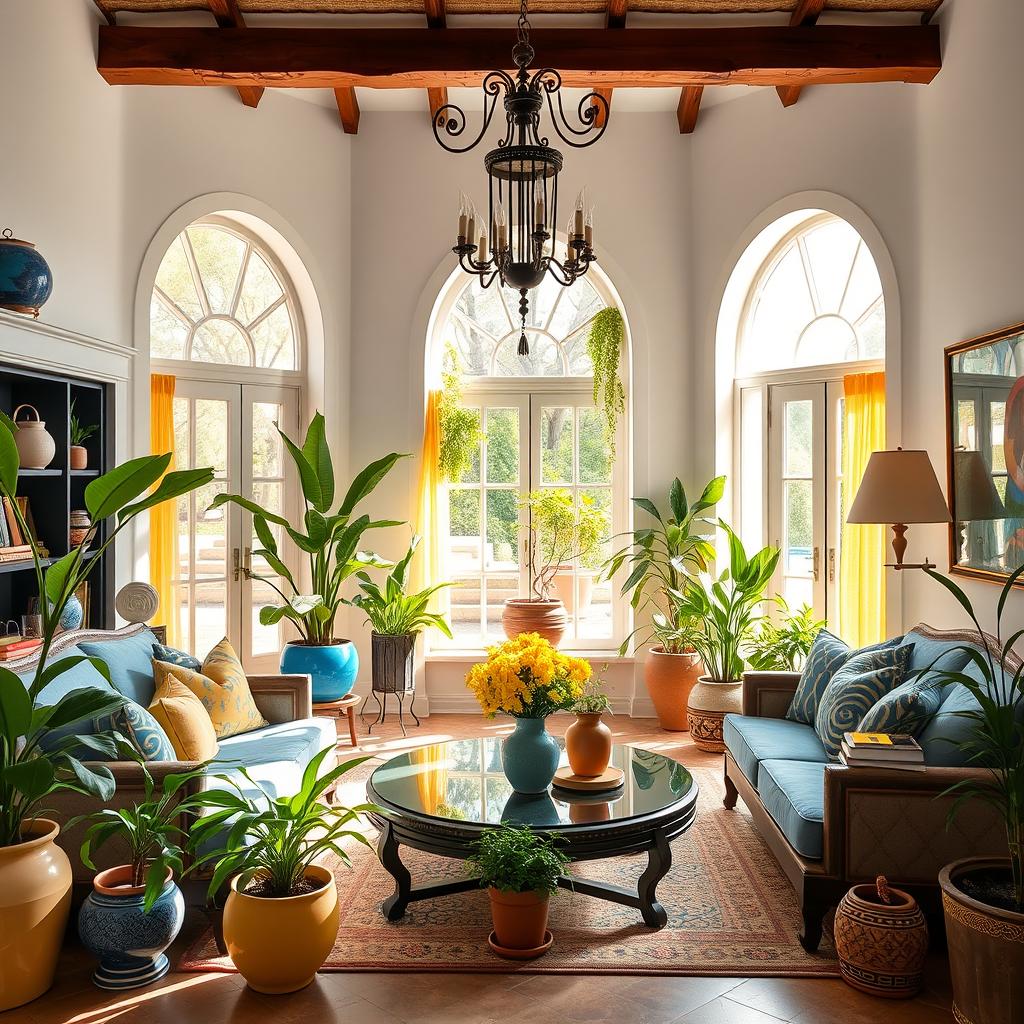
The Mediterranean interior design decor offers a wide range of styles, from rustic to ornate. By choosing these elements, homeowners can make their homes peaceful and elegant. This reflects the lasting charm of Mediterranean style.
Mediterranean Style: Indoor-Outdoor Living Spaces
The Mediterranean lifestyle loves mediterranean indoor outdoor living. Courtyards, Mediterranean patio design, and terraces are like extra rooms. They have comfy seats, greenery, and pretty fountains and tiles.
These spots are great for enjoying the weather and views. They make moving from inside to outside easy.
Creating a Mediterranean feel outdoors is key. Clearing the view makes these spaces look better. Rustic wood floors and big clay pots add to the coastal vibe.
Red clay tiles are common in Mediterranean outdoor areas. They work well in dry places. Light furniture and colors make the space feel airy and coastal.
Adding bright colors, like light blue, brings the Mediterranean to life. Decor like sand dollars or greenery adds to the theme. Mosaic art and Mediterranean plants complete the look.
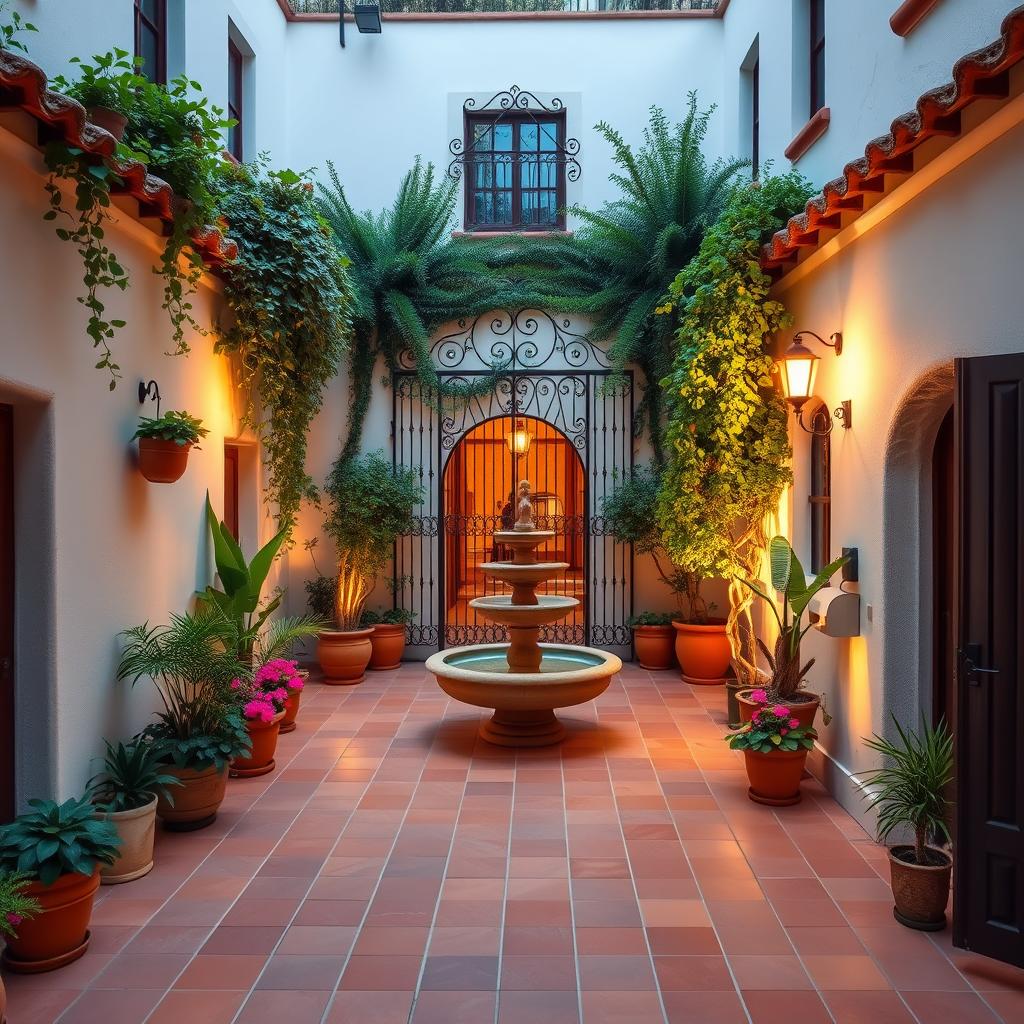
Mediterranean homes mix indoor and outdoor spaces beautifully. This creates a welcoming and stunning living area. The focus on natural materials and colors makes it special.
Incorporating Mediterranean Design into Your Home
Bringing Mediterranean-inspired interiors into your home is easy and can change your living spaces. Start with the colors that define this style. Use warm, earthy tones like beige, sand, and terracotta for walls and accents. These colors remind you of the Mediterranean coast, making your home feel calm and welcoming.
Use Natural Materials and Textures
To add a Mediterranean feel, use natural materials and textures. Choose wooden furniture with a rustic look and wrought iron accents for old-world charm. Add terracotta tiles, natural stone, and ceramic pieces for a touch of organic beauty.
Embrace Outdoor Living
Mediterranean Greek style interior design blends indoor and outdoor spaces perfectly. Make your patio or garden an extension of your home. Use comfortable seating and lots of greenery to feel like you’re in a Mediterranean villa. Outdoor rugs and lanterns make these areas cozy and inviting.
| Design Element | Mediterranean Inspiration |
|---|---|
| Color Palette | Warm, earthy tones like beige, sand, and terracotta |
| Materials | Natural wood, wrought iron, terracotta tiles, natural stone |
| Outdoor Living | Seamless indoor-outdoor spaces, abundant greenery, cozy seating |
By using Mediterranean design elements, you can make your home a peaceful, sunny oasis. Whether you love the rustic look of a Tuscan villa or the bright colors of a Greek island, this style lets you make your space your own. It brings the Mediterranean Sea to your doorstep.
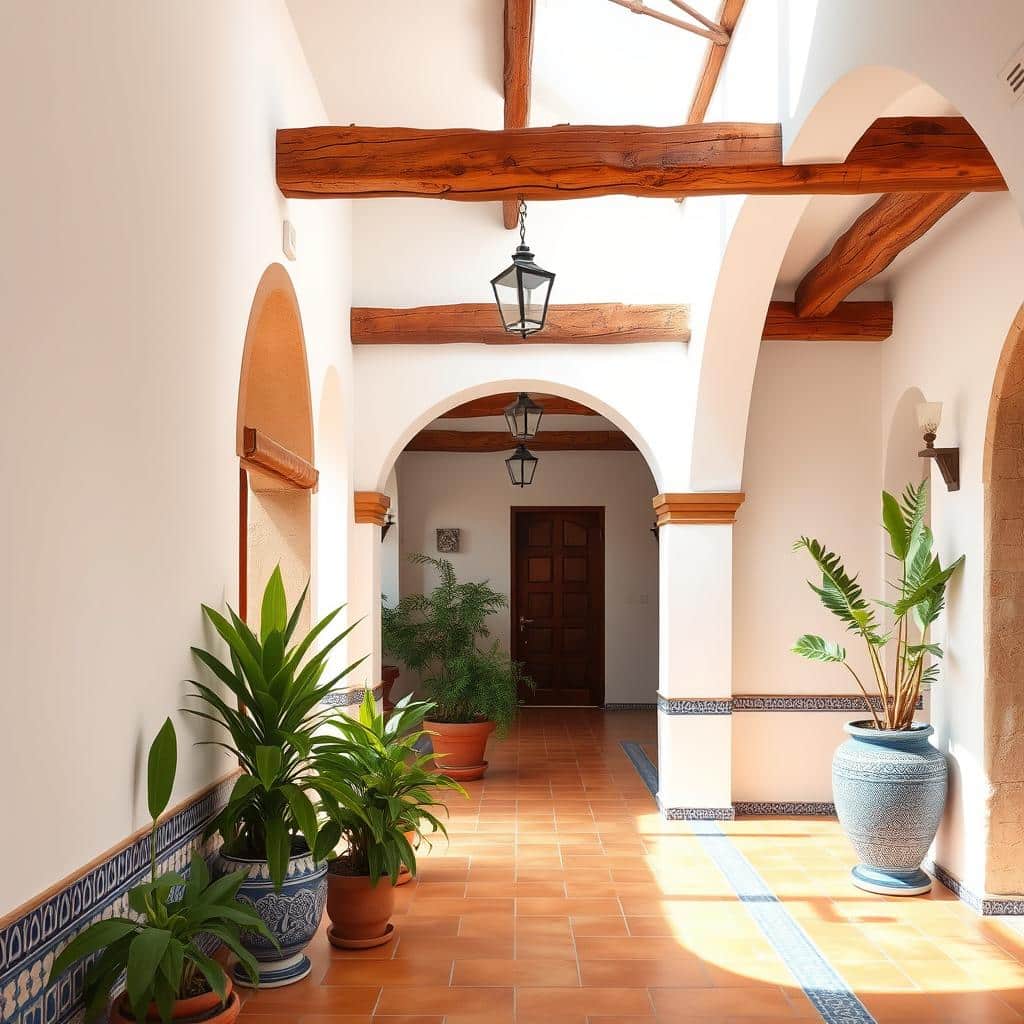
Mediterranean-Inspired Patterns and Motifs
Decorative elements are key in Mediterranean interior design. Intricate patterns and motifs are a big part of this style. Handcrafted ceramics and vibrant mosaic tiles add a rich, authentic feel to any room.
When adding Mediterranean design patterns and Mediterranean design motifs to your home, look for items that show the region’s iconic look. Decorative plates, vases, and bowls with detailed, Mediterranean style patterns can make a room look elegant and cultured.
Textiles are also vital in Mediterranean interior design. Look for traditional woven rugs, embroidered pillows, and patterned curtains. These items, along with handcrafted ceramics, create a stunning and touchable experience. They bring the Mediterranean’s essence into your home.
By carefully adding these Mediterranean design style patterns and Mediterranean design motifs to your space, you can create a timeless and captivating area. It will feel like a trip to the Mediterranean’s sunny shores.
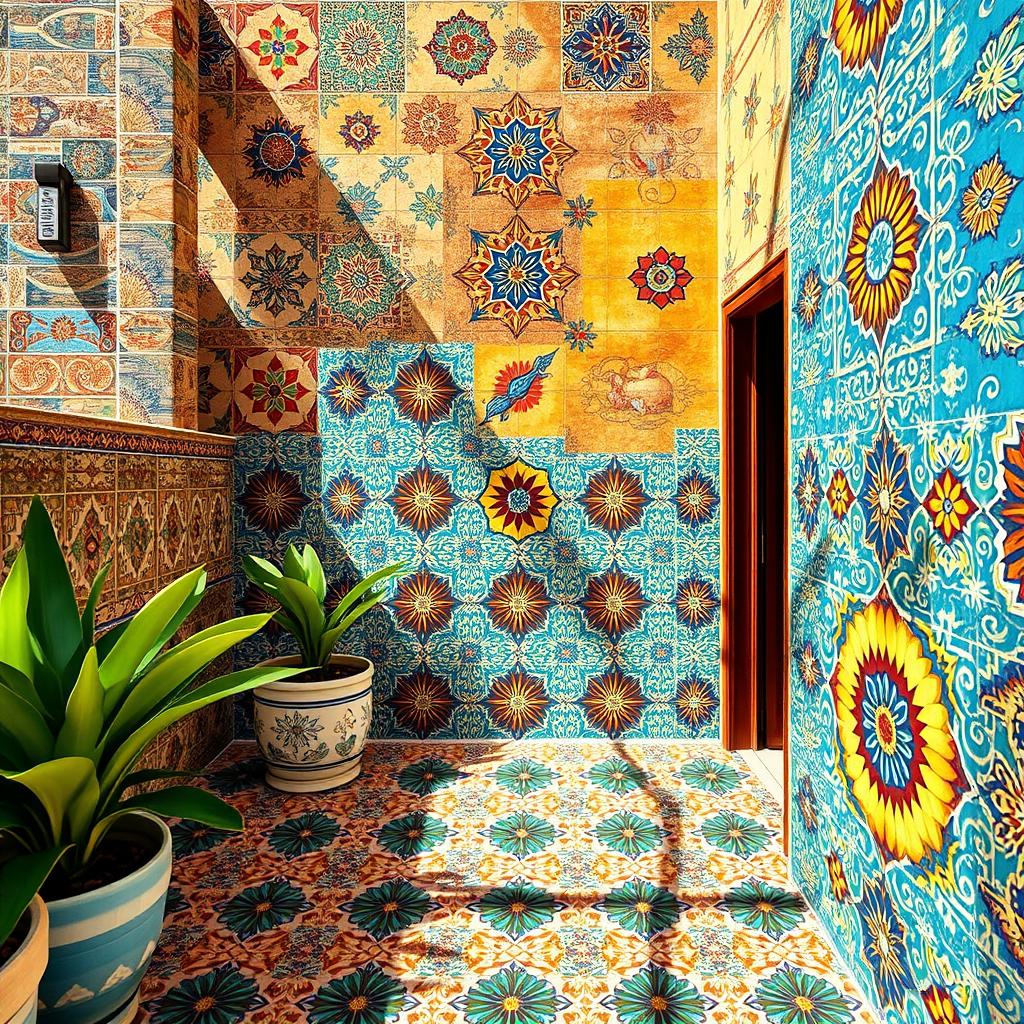
| Design Element | Typical Patterns and Motifs |
|---|---|
| Ceramics | Geometric patterns, floral motifs, tile mosaics |
| Textiles | Stripes, ikat, embroidery, kilim patterns |
| Architectural Details | Arches, columns, carved stonework, tile accents |
Rustic Furnishings and Vintage Finds
To get a true Mediterranean look, focus on Mediterranean rustic furniture and Mediterranean vintage decor. Look for distressed wooden tables and naively painted Mediterranean antique furniture. Also, find vintage accessories that show character and history. Mixing styles and eras creates a unique yet balanced look that honors the region’s rich culture.
Mediterranean design combines natural elements with timeless elegance. It brings the calm of a Mediterranean villa into homes. The colors include the sea’s blues, warm terracottas, and sunny yellows, making spaces feel like a coastal retreat. Big windows and open areas let in lots of light, making spaces feel airy and welcoming.
Mediterranean furniture is all about comfort and practicality. It uses open layouts, light colors, and natural materials like wood and wicker. Ornate tiles and mosaics add exotic charm to rooms. Mediterranean kitchens are both functional and beautiful, capturing the style’s essence.
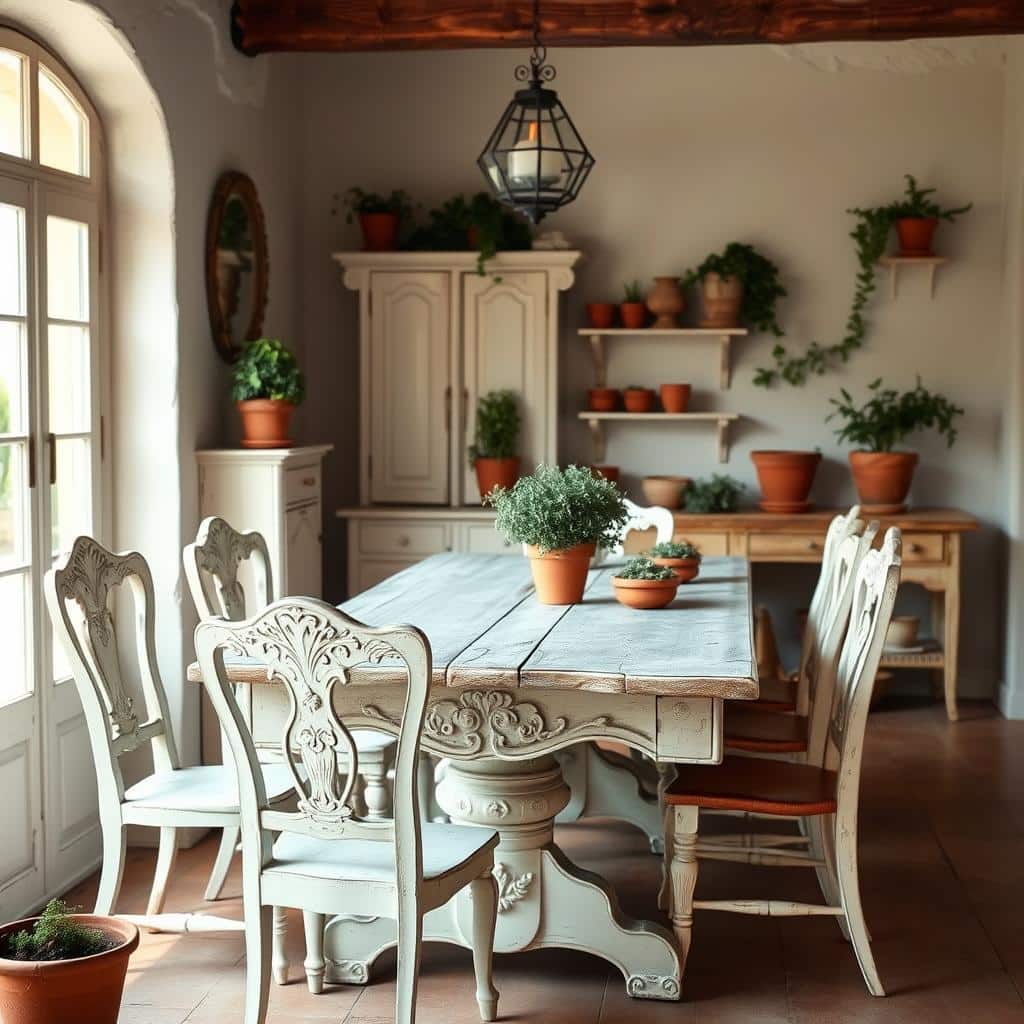
Accessories like maritime accents and seashore treasures add authenticity and charm. Mediterranean bedrooms and bathrooms feel like a spa with earthy tones and rustic textures. These elements bring the comfort and beauty of coastal living into your home.
To keep Mediterranean style alive, keep things simple and clutter-free. Soft pastels, bleached wood, and faded linens are key. Vintage coastal style is about reusing items, creating a timeless and harmonious space.
Prioritizing Light and Airy Spaces
Mediterranean home interior design loves light and open spaces. These homes feel like they blend indoors and outdoors. They offer a fresh, relaxed vibe. To get this feel, let lots of sunlight in through sheer curtains or blinds.
Choose lightweight, breezy fabrics for furniture and decor. This makes your space feel inviting and comfy. The aim is to mix indoor and outdoor spaces smoothly. This way, Mediterranean homes feel like a calm coastal retreat.
To make your Mediterranean light interior design even better, add Mediterranean bright interiors and Mediterranean open spaces. Use big windows, glass doors, and simple blinds to let in lots of light. This makes your space feel bigger and connects you to nature.
- Maximize natural light with sheer curtains and light-filtering blinds
- Opt for lightweight, breezy fabrics for upholstery and soft furnishings
- Incorporate large windows, expansive glass doors, and minimalist window treatments
- Cultivate a seamless indoor-outdoor living experience
- Embrace the essence of coastal living with a light and airy design approach
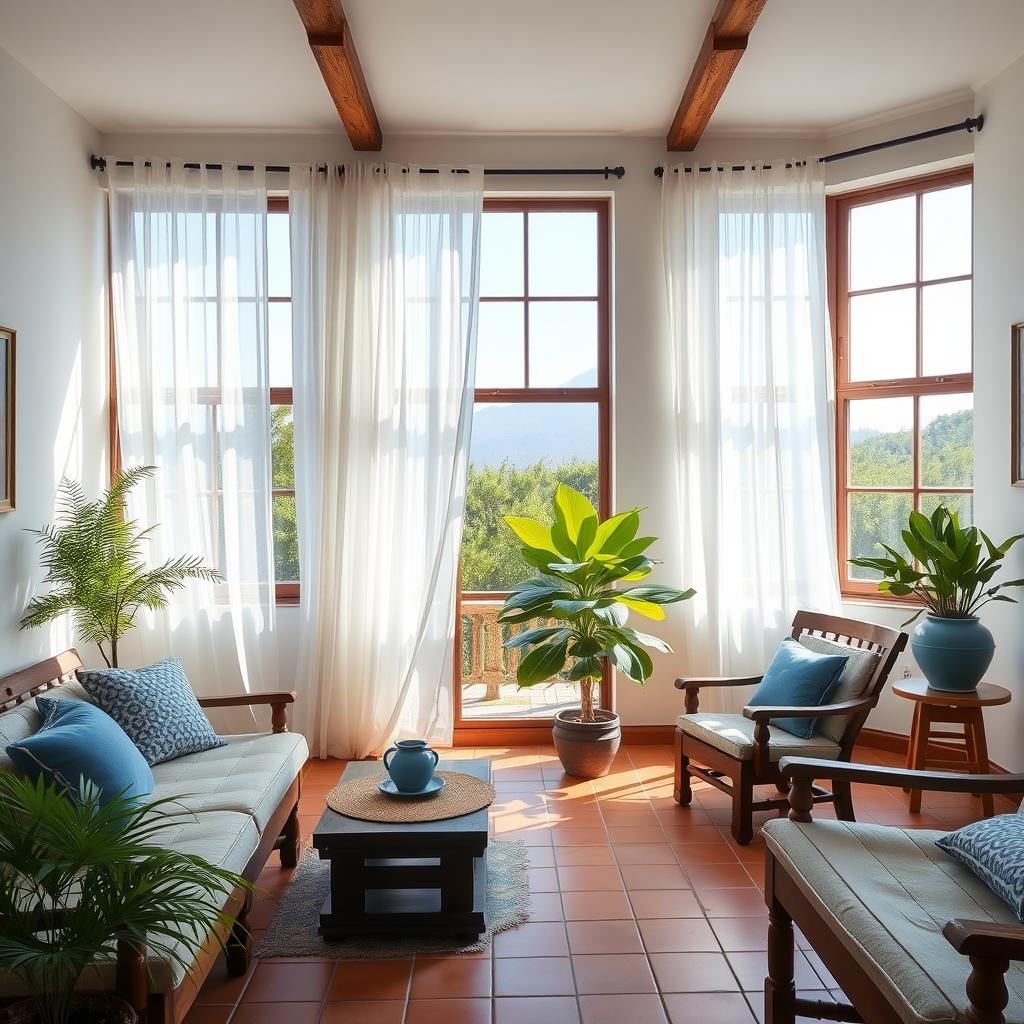
Mediterranean-inspired interiors bring the calm of coastal living into your home. They create a peaceful, welcoming space that touches your senses.
Conclusion
Mediterranean Interior Design is a timeless and captivating style. It celebrates the natural beauty and cultural richness of the Mediterranean. It creates spaces that feel serene and vibrant, with warm colors and natural materials.
This design approach offers endless possibilities for beautiful and functional spaces. Whether you like rustic charm, minimalist elegance, or traditional appeal, there’s something for everyone. Mediterranean design blends the past and present, creating a sense of timelessness.
Starting your own Mediterranean design journey is exciting. It connects us to nature and the region’s rich culture. By embracing Mediterranean design principles, you can make your home a serene and harmonious haven. It will reflect your personal style and the spirit of the Mediterranean.
FAQ
What is Mediterranean Interior Design?
Mediterranean Interior Design is all about warmth, relaxation, and a love for nature. It draws inspiration from the beautiful coastlines of Southern Europe. Countries like Greece, Spain, Italy, and Morocco are key sources of this timeless style.
What are the historical influences on Mediterranean Interior Design?
This design style combines many cultures. It’s influenced by ancient Greek architecture, Spanish Villas, Moroccan riads, and more. The Italian Renaissance and Ottoman Empire’s architecture also play a part.
What are the key characteristics of Mediterranean Interior Design?
It’s known for its vibrant colors and natural materials like stone and wood. Furniture is sturdy yet elegant, with a focus on craftsmanship. Decor often includes ceramics, mosaics, and lots of greenery.
What are the typical architectural elements of Mediterranean Design?
Mediterranean homes have high ceilings, arches, big windows, and open layouts. These features make spaces feel airy and welcoming.
How can I incorporate Mediterranean Design into my home?
Begin with warm colors and natural materials. Add ceramics and mosaics for decoration. Make your indoor and outdoor spaces feel connected with comfortable seating and plants.
What are the typical patterns and motifs used in Mediterranean Design?
You’ll see lots of patterns and motifs in Mediterranean homes. Think decorative plates, vases, and textiles with bold colors and traditional designs.
How can I achieve a more authentic Mediterranean aesthetic in my home?
Use rustic furniture and vintage items to add character. Mixing different styles and eras can also bring a sense of cultural richness to your space.
What is the significance of light and airy spaces in Mediterranean Design?
Mediterranean interiors aim for a fresh, relaxed vibe. They use lots of natural light and light fabrics to feel open and airy.
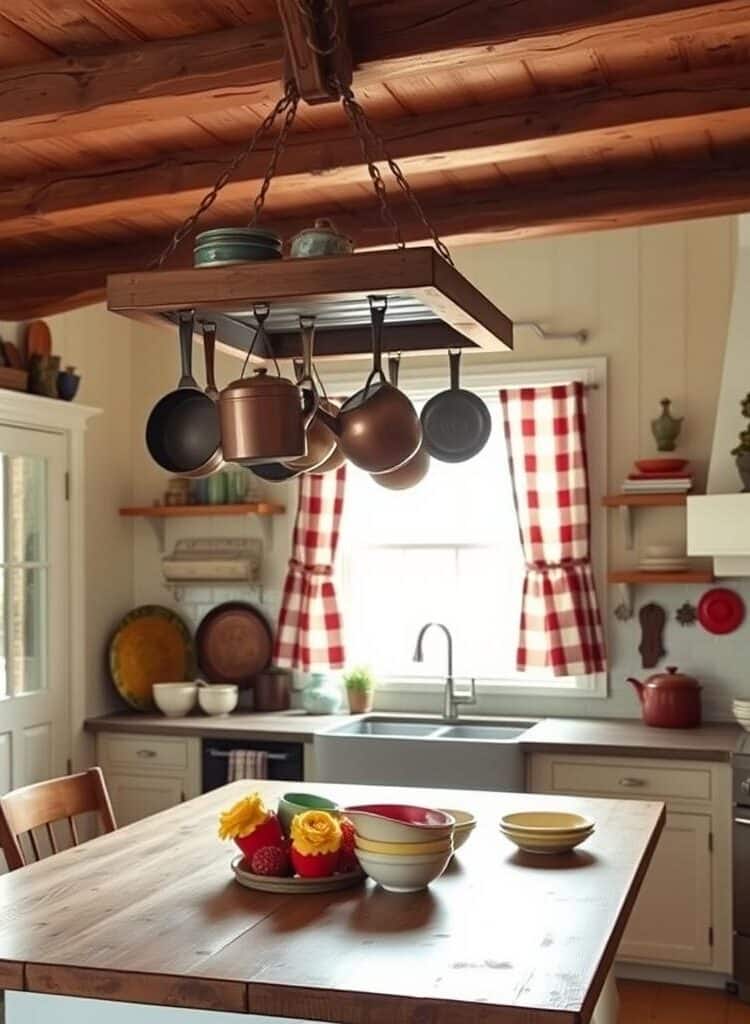
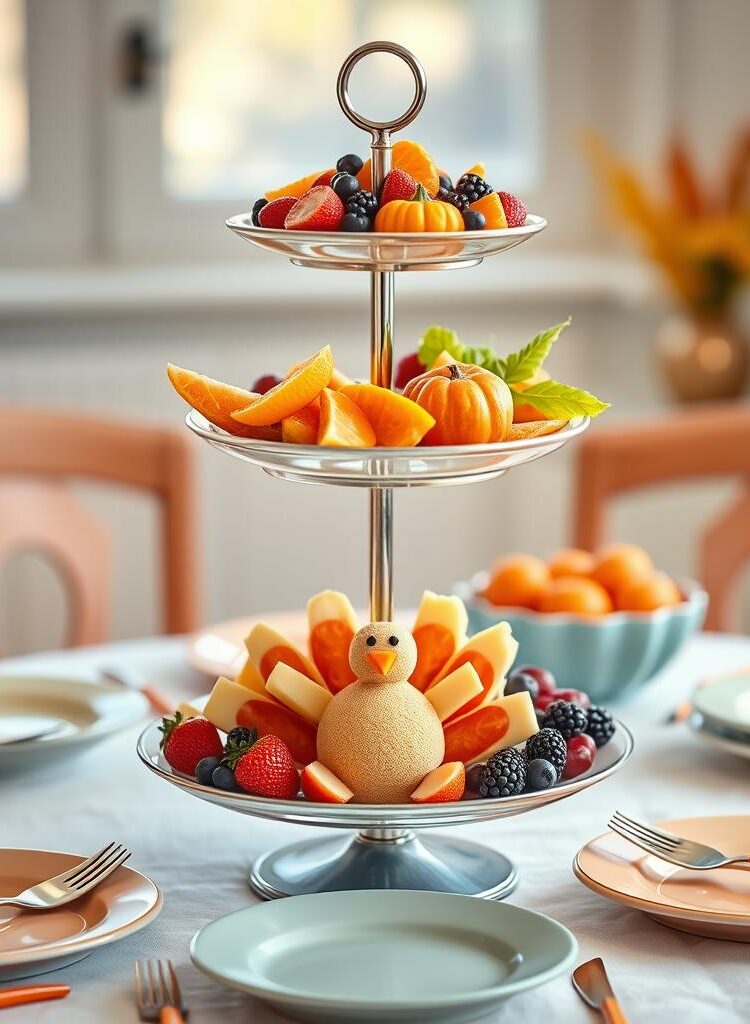
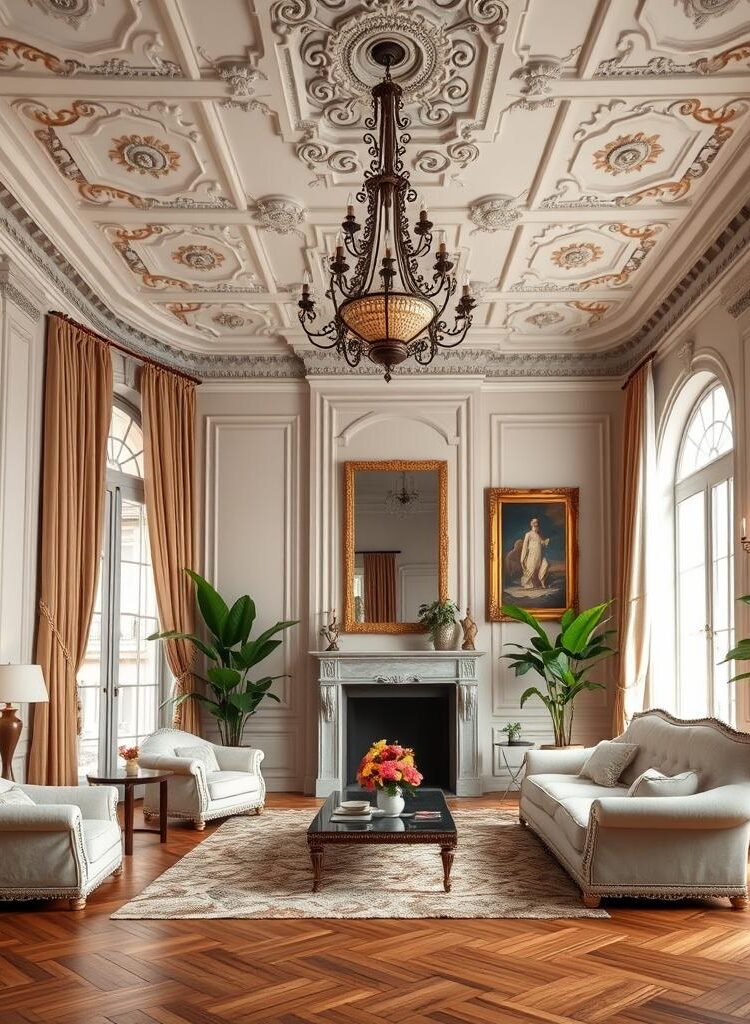
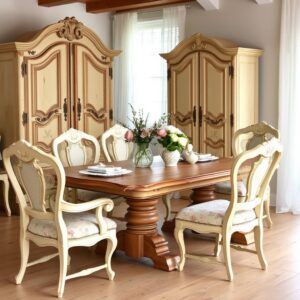
Leave a Reply